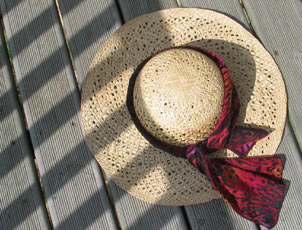The Best Sunscreens for Green Living? Broad-brimmed Hats!
Which are the best sunscreens for skin safety and effective protection?
What can we do to shield ourselves from the worst of the sun's rays? How can we tell if our sun protection methods are environmentally friendly? This page tries to answer these questions.
The best sunscreens have to be hats!
And then there's parasols, custom T-shirts, saris and lungis and any other method of making shade for yourself. All those Texans, Mexicans and Ascot ladies just cannot be wrong!
Nevertheless, good as these methods are, there are times when you just want to run about in the sun without the encumbrance of too many clothes. Done, judiciously, this can be good for your health.
Fortunately, good organic sunscreen does exist which is far better for the environment as well as our health in most cases.
Sunshine and Vitamins
New research at the University of California shows that the vitamin D that we get from the sun is more effective than that which is found in foods. It protects us from cancers and diabetes, so there are good arguments for getting a gradual healthy tan. Moderation in all things, I guess!
As part of your Greenfootsteps green living guide, here are some ideas on how to protect yourself from the sun's rays and still be environmentally friendly.
But first, a little about commercial sunscreens - the run of the mill, non-organic kind..
"The ideal sunscreen would be highly effective at blocking both UVA and UVB rays, contain active ingredients that do not break down in the sun (so that the product remains effective), and contain active and inactive ingredients that are proven to be safe for both adults and children. Unfortunately, there is no sunscreen that meets all of these criteria,..."
- EWG
One of the very best sunscreens - a broad-brimmed hat!
There are many expensive creams and lotions available in supermarkets and chemists to smooth on your skin in the hope of achieving a good tan without endangering your health.
Free radicals
The uncomfortable news is that some of the ingredients of many commercial sunscreens are toxic and can cause damage to your health. Many have been found to cause free radicals which can damage your metabolism.
A bit of a devil's bargain, really.
Even some sunscreens using mainly organic ingredients have been found to cause free-radical damage. So, if you buy such products, do your research by reading the ingredients list and checking with organisations such as EWG.
The EWG (The Environmental Working Group - a US organisation), has spent 18 months researching sun creams. They found that 84% of 783 sunscreen products tested offer inadequate protection from the sun or contain ingredients that give rise to significant safety concerns.
(If you would like to check particular products for yourself here is a link to the EWG site Skindeep.)
Here's a brief look at some of the ingredients found in many sun creams and lotions.
Best Sunscreens: What is in commercial sunscreen products?
Many commercial sunscreens contain typically oxybenzone, which absorbs both UVA an UVB light. UVA sunlight leads to damage and aging of the skin. UVB light leads to sunburn. The problem with oxybenzone is that it is now thought to cause some skin cancers itself.
Titanium dioxide and/or zinc oxide are often included too, as they are opaque and stop much of the ultraviolet radiation from penetrating the skin. Titanium dioxide is thought to be harmless but zinc oxide is harmful to the environment.
Best Sunscreens: What are free-radicals?
Free radicals are highly reactive chemicals which cause tissue damage. Free radicals have a role in ageing. Your body is better able to cope with free radicals if you eat a vitamin-rich diet.
Nevertheless, it is better to avoid unnecessary exposure to free radicals.
Ultraviolet (UV) irradiation from sunlight causes free radical damage to human cells. There are two main types of UV light in sunlight - and many sunblocks only block one of them (UVB), leaving the skin exposed to UVA. UVA is now thought to be responsible for many melanomas and skin damage. It creates reactive chemicals (free radicals) which then cause damage to cells.
Here's a book which takes a practical approach to saving your skin from too much exposure.
Sun Protection For Life: Your Guide To A Lifetime Of Healthy & Beautiful Skin There are sections on melanomas and other skin cancers and ways to ensure that these frightening diseases do not affect you and your family.
Aloe Vera is one of the most wonderful treatments for sunburn. Use it as a soothing after-sun lotion. See below under "Dealing with Sunburn" for more details.
Best Sunscreens: What are the alternatives to chemical sunsreens and sunblocks?
There are now many alternatives which are less damaging. Many of the companies which specialise in non-toxic body care products have started producing sunscreen with bio-friendly and relatively harmless ingredients.
One of the main ingredients of natural sunscreens is often titanium dioxide. This chemical produces a strong whitish glaze when smoothed onto skin and it is capable of reflecting away most of the harmful rays of the sun.(Titanium white is a staple of oil painters.)
It is believed to be very safe but when you wear it on your face you do look as if you are studying to become a geisha!
But best of all is a good hat and sufficient shading when the sun is at its strongest.
Remember the Australian Slip, Slop, Slap campaign?
In the eighties skin cancer had reached almost epidemic proportions in Australia. The campaign encouraged people to slip into some clothing, slop on some sunscreen and slap on a hat - and preferably sun glasses, too.
The message worked and the skin cancer rates plummeted. The advice still holds good today, only the best sunscreens to slop on are natural sunscreens with titanium dioxide and other health-friendly and environment-friendly ingredients.
If you do like being in the sun and like to develop a tan, increase your exposure to the sun gradually and take advantage of natural shade during the hottest part of the day.
Sitting beneath a tree in dappled shade you are protected from a lot of (but not all) the ultraviolet radiation that does the damage to your skin.
However, you should still limit your exposure to sunlight, even when sitting under a tree.
Some radiation does still get through.

Another of the best sunscreens - a broad-leafed tree!
Best Sunscreens: Dealing with sunburn
If you get seriously burned it can affect your health later in life. It may even be life-threatening at the time - it is a real burn and can cause deep damage like other burns.
Bad sunburn should be treated properly and should be seen by a health professional. If there is any blistering or extensive skin damage or the victim is elderly or very young it is best to seek advice.
Benefits of aloe vera
If there is just a low level of redness and inflamed skin, one of the very best remedies is aloe vera gel. This is now used in some hospitals to treat burns. You can use it at home, too.
See Aloe Vera The New Millennium: The Future of Wellness in the 21st Century for details of how to use this amazing natural healer. Aloe Vera: Nature's Soothing Healer is also very helpful and contains some information about research into aloe vera uses.
Vitamin E cream is also useful. Avoid creams containing parabens. Wheatgerm oil is a good source of vitamin E (but it must be fresh - bottled oil easily turns rancid after a few months.
You can also bathe the affected parts in water with a little baking soda added. It is soothing and cooling.
Calendula cream (from marigolds) is also very soothing and promotes faster healing of damaged skin.
Vitamin in C and vitamin A will help your body to cope with the damage and will promote faster healing.
The Best Sunscreens are Natural Sunscreens! TOP
Natural Body Care
Greenfootsteps Home - for more easy green living ideas
| Tweet |

| Tweet |

Sponsored links
Footprints
- an occasional e-zine from Greenfootsteps
If you would like to receive the e-zine, please just sign up below.







New! Comments
Have your say about what you just read! Leave me a comment in the box below.